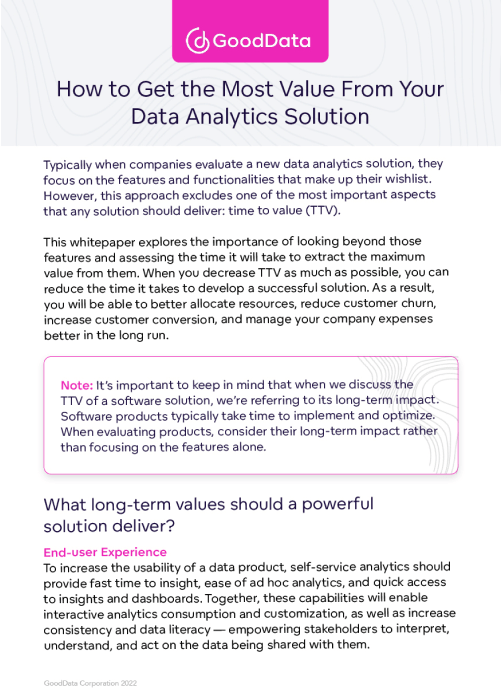Typically when companies evaluate a new data analytics solution, they focus on the features and functionalities that make up their wishlist. However, this approach excludes one of the most important aspects that any solution should deliver: time to value (TTV).
This whitepaper explores the importance of looking beyond those features and assessing the time it will take to extract the maximum value from them. When you decrease TTV as much as possible, you can reduce the time it takes to develop a successful solution. As a result, you will be able to better allocate resources, reduce customer churn, increase customer conversion, and manage your company expenses better in the long run.
Note: It’s important to keep in mind that when we discuss the TTV of a software solution, we’re referring to its long-term impact. Software products typically take time to implement and optimize. When evaluating products, consider their long-term impact rather than focusing on the features alone.
What long-term values should a powerful solution deliver?
End-user Experience
To increase the usability of a data product, self-service analytics should provide fast time to insight, ease of ad hoc analytics, and quick access to insights and dashboards. Together, these capabilities will enable interactive analytics consumption and customization, as well as increase consistency and data literacy — empowering stakeholders to interpret, understand, and act on the data being shared with them.
After GoodData customer Zendesk introduced analytics to its platform, it found that 80% of its Plus and Enterprise customers continued to use advanced analytics every day, creating a stickier relationship with the product and reducing the likelihood of customer churn.
Analytics Engineer Experience
Your analytics engineers’ experience with your solution is equally important to consider, and they will benefit from the ability to automate change management, collaboration, and (de)provisioning of users and user groups. The ability to manage the solution via CI/CD pipelines, automated and continuous delivery, versioning, merges, and rollouts are all important aspects of the value chain to include. Why? Because they will grant your developers stronger governance options and help them save time on maintenance processes.
On top of that, the overall flexibility of the solution in terms of embedding options, integration with third-party charting libraries for custom visualizations and interactivity, access to a variety of SDKs and programming languages, and deployment to any cloud (public, private, or hybrid) will be highly beneficial in reducing costs and saving analytics engineers’ time.
Zartico has successfully leveraged GoodData’s automation features to greatly accelerate the release of product updates, pushing out over 80 enhancements to end users in just six months.
Openness
The solution’s openness is another key component to consider. What is more important than having a solution that can support millions of connectors is the ability to switch between the ones you have.
Regardless of the size of the implementation, ongoing maintenance processes will involve transferring data to new storage systems, new databases, and so on. Switching between these data sources should be easy and not require changes in the LDM or linked structures.
A large payment processor partnering with GoodData was able to deliver dashboards with requested data insights to their customers in just seven weeks. Before GoodData, they spent $2M over two years trying to build the product through an alternative analytics solution without success.
An open solution that will provide the most value will be futureproof and compatible with different ecosystems. It will be data source agnostic — allowing for backend changes, UI changes, and consumption changes without breaking or requiring rework — to significantly decrease long-term spend and require fewer engineering resources.
Scalability
A product is only as strong as its scalability. The ability to scale in terms of number of users, user groups, data volume, performance, and pricing are crucial components that should not be overlooked. Without them, you’ll soon reach your solution’s limits and rack up unnecessary costs and performance issues before searching for another solution to migrate to — all the while delaying TTV for your customers.
A large payment processor partnering with GoodData was able to deliver dashboards with requested data insights to their customers in just seven weeks. Before GoodData, they spent $2M over two years trying to build the product through an alternative analytics solution without success.
Total Cost of Ownership
Having an ideal multi-tenant solution comes at a certain cost. However, if the tool will allow you to enable enterprise-wide alignment on metrics definitions, empower users with data distributed via self-service data products or innovative apps, and allow for wider adoption of data, you will be able to minimize the total cost of ownership.
With all the above mentioned automation features supporting both end users and developers, costs will become predictable as BI teams’ involvement is minimized. Rather than creating additional costs, the solution will instead support the growth of your business.
Continue Reading This Article
Enjoy this article as well as all of our content.
Does GoodData look like the better fit?
Get a demo now and see for yourself. It’s commitment-free.











